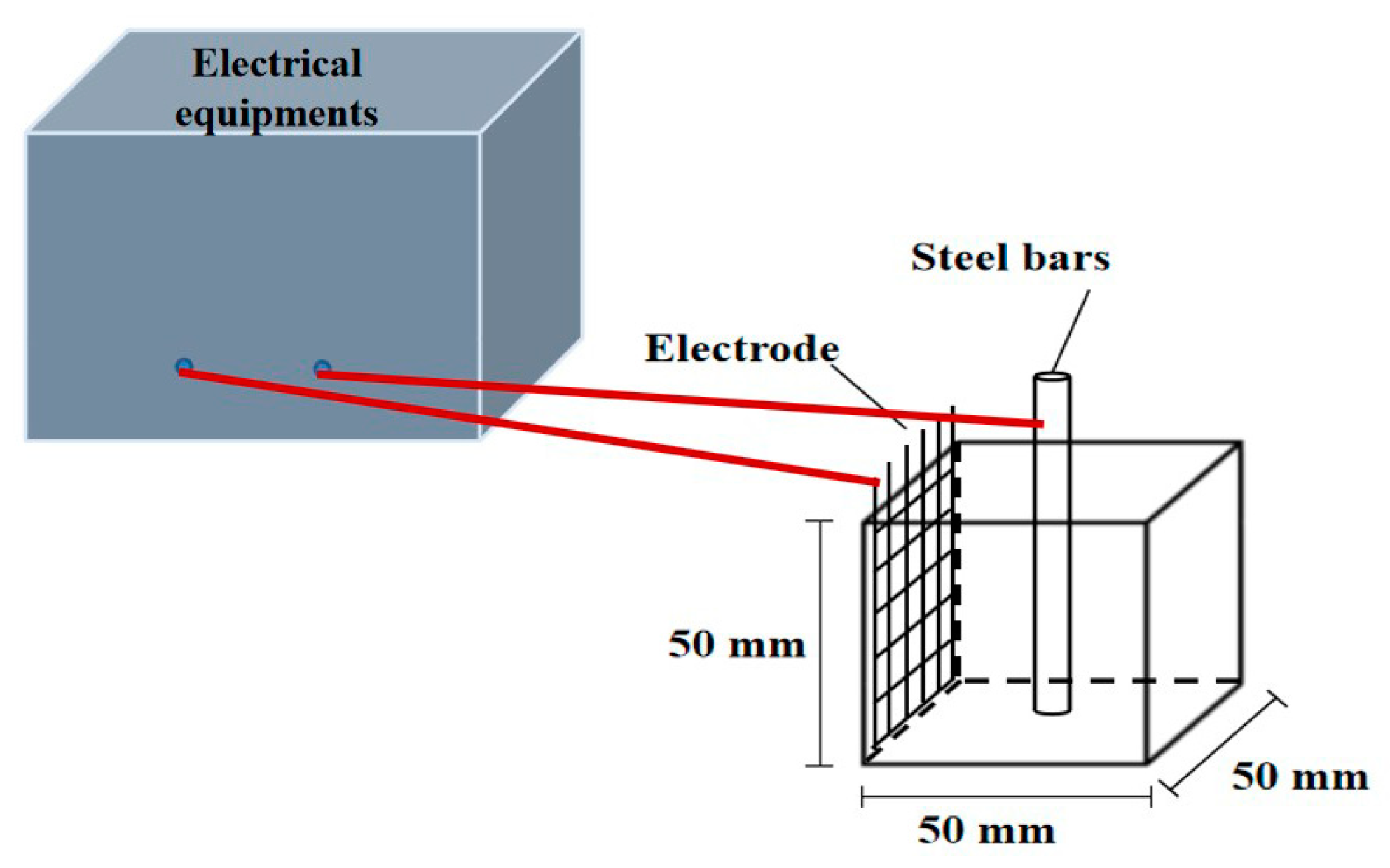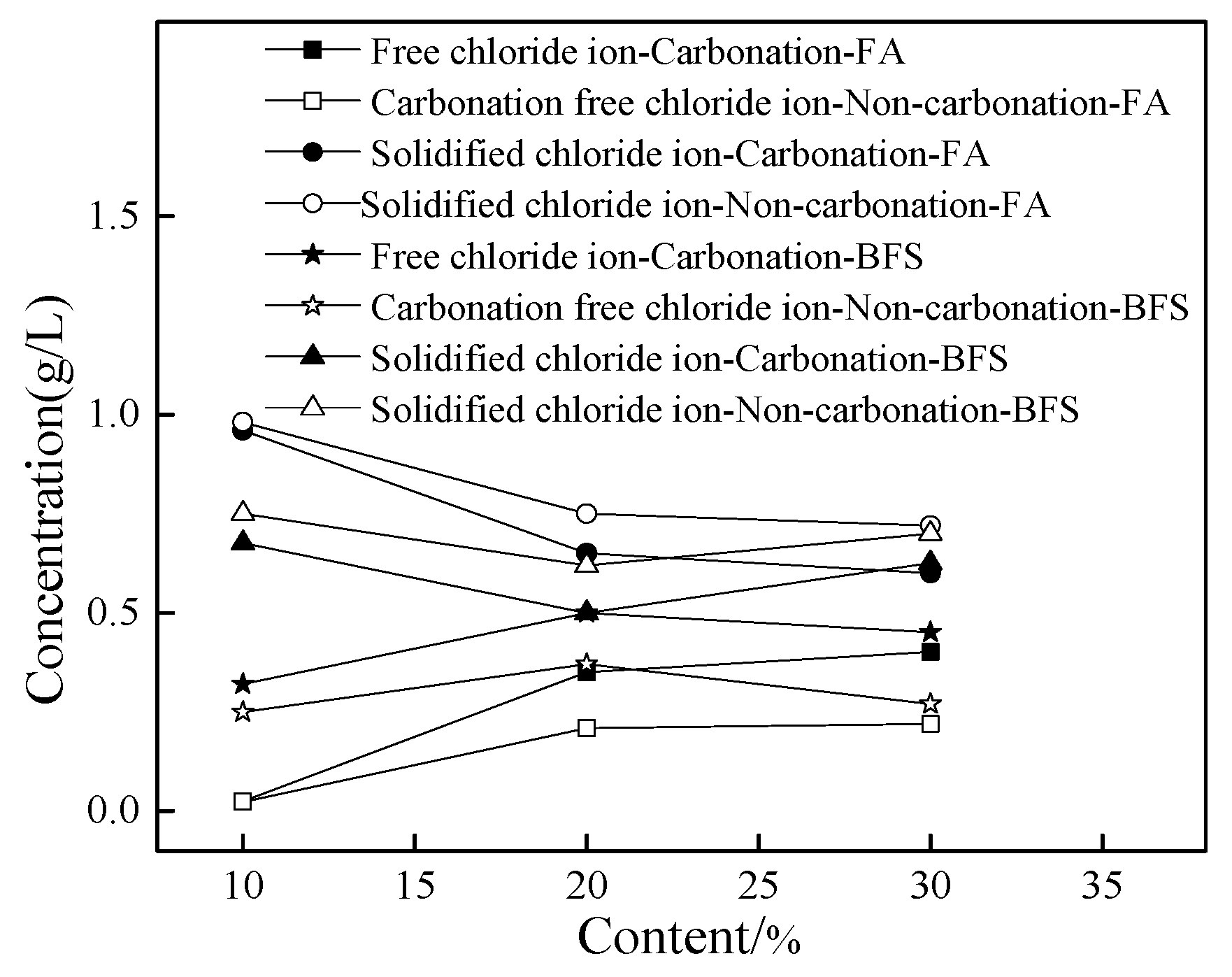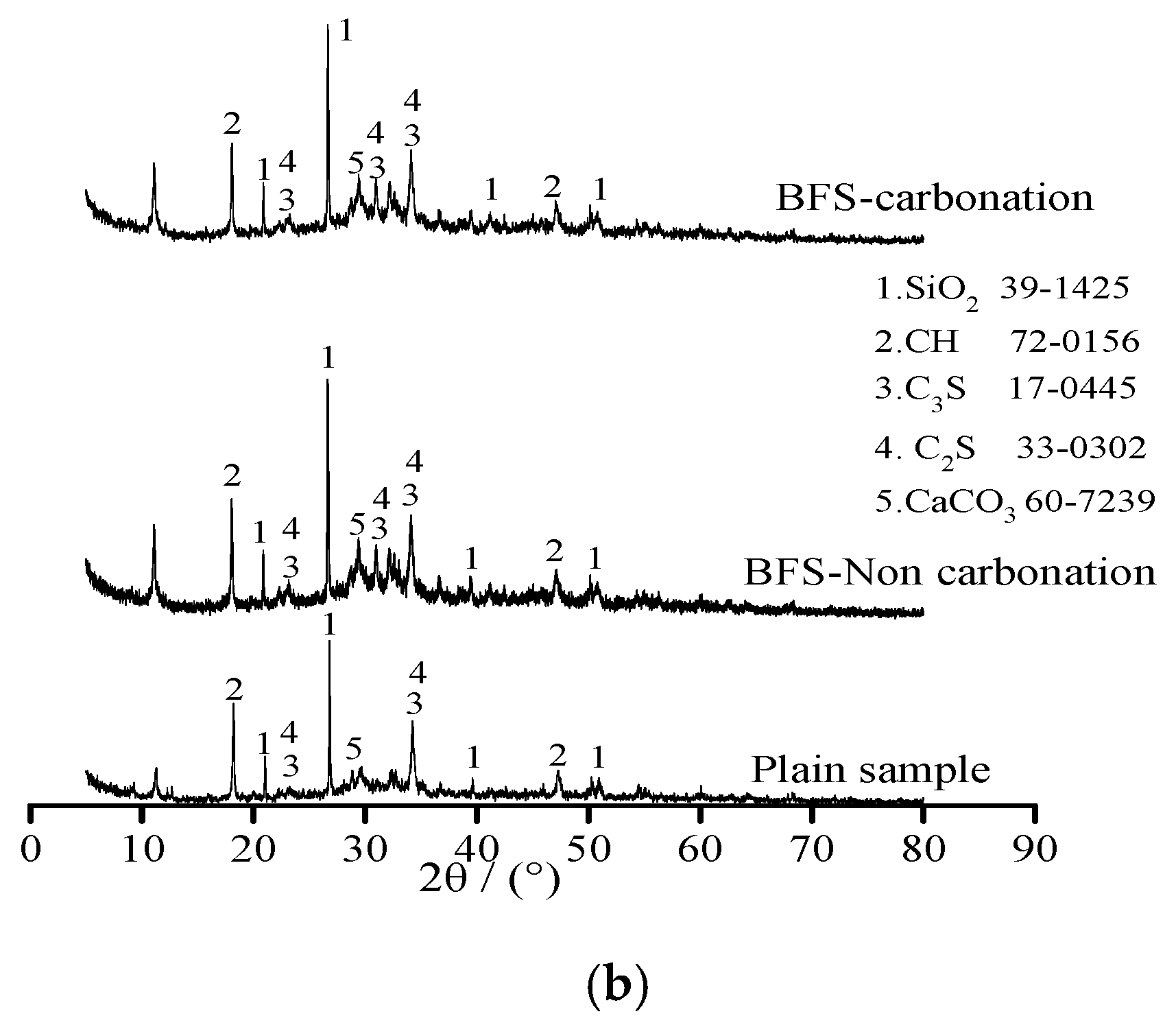Research on the Influence of Carbonation on the Content and State of Chloride Ions and the Following Corrosion Resistance of Steel Bars in Cement Paste
Abstract
1. Introduction
2. Experimental
2.1. Raw Materials
2.2. Samples Preparation and Measurement
3. Results and Discussion
3.1. The State and Content of Chlorine in Cement Paste
3.2. Corrosion Resistance of Steel Bars
4. Conclusions
- Compared with the plain cement paste under the carbonation environment, the addition of fly ash and blast furnace slag powder caused larger solidification of chloride ions in cement-based materials due to larger specific surface area and adsorption capacity. Moreover, cement paste with granulated blast furnace slag powder showed the largest solidification capacity of chloride ions.
- The amount of solidified chloride ion was decreased, and the amount of free chloride ions was increased by the carbonation effect leading to accelerating the corrosion of reinforcement.
- According to the results of AC electrical resistance and AC impedance spectroscopy, it can be found that the corrosion resistance of specimens decreased in this order of Carbonation-Plain < Plain < Carbonation-BFS < Carbonation-FA.
Author Contributions
Funding
Conflicts of Interest
References
- He, B.; Gao, Y.; Qu, L.; Duan, K.; Zhou, W.; Pei, G. Characteristics analysis of self-luminescent cement-based composite materials with self-cleaning effect. J. Clean. Prod. 2019, 225, 1169–1183. [Google Scholar] [CrossRef]
- Cao, T.; Lijuan, Z.; Guowen, S.; Caihui, W.; Ying, Z.; Pengshuo, W.; Aoxue, X. Simulation of chloride ion transport in concrete under the coupled effects of a bending load and drying–wetting cycles. Constr. Build. Mater. 2020, 241, 118045. [Google Scholar] [CrossRef]
- Tan, H.; Li, M.; He, X.; Su, Y.; Zhang, J.; Pan, H.; Yang, J.; Wang, Y. Preparation for micro-lithium slag via wet grinding and its application as accelerator in portland cement. J. Clean. Prod. 2020, 250, 119528. [Google Scholar] [CrossRef]
- Yang, J.; Huang, J.; Su, Y.; He, X.; Tan, H.; Yang, W.; Strnadel, B. Eco-friendly treatment of low-calcium coal fly ash for high pozzolanic reactivity: A step towards waste utilization in sustainable building material. J. Clean. Prod. 2019, 238, 117962. [Google Scholar] [CrossRef]
- Gao, Y.; Qu, L.; He, B.; Dai, K.; Fang, Z.; Zhu, R. Study on effectiveness of anti-icing and deicing performance of super-hydrophobic asphalt concrete. Constr. Build. Mater. 2018, 191, 270–280. [Google Scholar] [CrossRef]
- He, X.; Zheng, Z.; Yang, J.; Su, Y.; Wang, T.; Strnadel, B. Feasibility of incorporating autoclaved aerated concrete waste for cement replacement in sustainable building materials. J. Clean. Prod. 2020, 250, 119455. [Google Scholar] [CrossRef]
- Liu, X.; Ma, B.; Tan, H.; Gu, B.; Zhang, T.; Chen, P.; Li, H.; Mei, J. Effect of aluminum sulfate on the hydration of Portland cement, tricalcium silicate and tricalcium aluminate. Constr. Build. Mater. 2020, 232, 117179. [Google Scholar] [CrossRef]
- Castaldo, P.; Palazzo, B.; Mariniello, A. Effects of the axial force eccentricity on the time-variant structural reliability of aging r.c. cross-sections subjected to chloride-induced corrosion. Eng. Struct. 2017, 130, 261–274. [Google Scholar] [CrossRef]
- Cheung, M.M.; Zhao, J.; Chan, B.Y.B. Service life prediction of RC bridge structures exposed to chloride environments. J. Bridg. Eng. 2009, 14, 164–178. [Google Scholar] [CrossRef]
- Ben Mansour, H.; Dhouibi, L.; Idrissi, H. Effect of phosphate-based inhibitor on prestressing tendons corrosion in simulated concrete pore solution contaminated by chloride ions. Constr. Build. Mater. 2018, 171, 250–260. [Google Scholar] [CrossRef]
- Glass, G.; Buenfeld, N. The influence of chloride binding on the chloride induced corrosion risk in reinforced concrete. Corros. Sci. 2000, 42, 329–344. [Google Scholar] [CrossRef]
- Shi, W.; Wang, T.-Z.; Dong, Z.-H.; Guo, X.-P. Application of wire beam electrode technique to investigate the migrating behavior of corrosion inhibitors in mortar. Constr. Build. Mater. 2017, 134, 167–175. [Google Scholar] [CrossRef]
- Wang, H.; Zhang, A.; Zhang, L.; Liu, J.; Han, Y.; Shu, H.; Wang, J. Study on the influence of compound rust inhibitor on corrosion of steel bars in chloride concrete by electrical parameters. Constr. Build. Mater. 2020, 262, 120763. [Google Scholar] [CrossRef]
- Wang, H.; Zhang, A.; Zhang, L.; Wang, Q.; Yang, X.-H.; Gao, X.; Shi, F. Electrical and piezoresistive properties of carbon nanofiber cement mortar under different temperatures and water contents. Constr. Build. Mater. 2020, 265, 120740. [Google Scholar] [CrossRef]
- Chi, L.; Wang, Z.; Lu, S.; Zhao, D.; Yao, Y. Development of mathematical models for predicting the compressive strength and hydration process using the EIS impedance of cementitious materials. Constr. Build. Mater. 2019, 208, 659–668. [Google Scholar] [CrossRef]
- Ogirigbo, O.; Ukpata, J. Effect of chlorides and curing duration on the hydration and strength development of plain and slag blended cements. J. Civ. Eng. Res. 2017, 7, 9–16. [Google Scholar]
- Kang, K.; Lee, C.-G.; Choi, J.-W.; Kim, Y.-K.; Park, S.-J. Evaluation of the use of sea sand, crushed concrete, and bentonite to stabilize trace metals and to interrupt their release from contaminated marine sediments. Water Air Soil Pollut. 2016, 227, 308. [Google Scholar] [CrossRef]
- Yang, J.; Su, Y.; He, X.; Tan, H.; Jiang, Y.; Zeng, L.; Strnadel, B. Pore structure evaluation of cementing composites blended with coal by-products: Calcined coal gangue and coal fly ash. Fuel Process. Technol. 2018, 181, 75–90. [Google Scholar] [CrossRef]
- Rêgo, J.; Nepomuceno, A.; Figueiredo, E.; Hasparyk, N. Microstructure of cement pastes with residual rice husk ash of low amorphous silica content. Constr. Build. Mater. 2015, 80, 56–68. [Google Scholar] [CrossRef]
- Qin, L.; Gao, X.; Su, A.; Li, Q. Effect of carbonation curing on sulfate resistance of cement-coal gangue paste. J. Clean. Prod. 2020, 278, 123897. [Google Scholar] [CrossRef]
- Li, J.; Yang, S.; Liu, Y.; Muhammad, Y.; Su, Z.; Yang, J. Studies on the properties of modified heavy calcium carbonate and SBS composite modified asphalt. Constr. Build. Mater. 2019, 218, 413–423. [Google Scholar] [CrossRef]
- Alhozaimy, A.; Hussain, R.R.; Al-Negheimish, A. Electro-chemical investigation for the effect of rebar source and surface condition on the corrosion rate of reinforced concrete structures under varying corrosive environments. Constr. Build. Mater. 2020, 244, 118317. [Google Scholar] [CrossRef]
- James, A.; Bazarchi, E.; Chiniforush, A.; Aghdam, P.P.; Hosseini, M.R.; Akbarnezhad, A.; Martek, I.; Ghodoosi, F. Rebar corrosion detection, protection, and rehabilitation of reinforced concrete structures in coastal environments: A review. Constr. Build. Mater. 2019, 224, 1026–1039. [Google Scholar] [CrossRef]
- Lei, L.; Wang, Q.; Xu, S.; Wang, N.; Zheng, X. Fabrication of superhydrophobic concrete used in marine environment with anti-corrosion and stable mechanical properties. Constr. Build. Mater. 2020, 251, 118946. [Google Scholar] [CrossRef]
- Liang, J.; Zhu, H.; Chen, L.; Han, X.; Guo, Q.; Gao, Y.; Liu, C. Rebar corrosion investigation in rubber aggregate concrete via the chloride electro-accelerated test. Materials 2019, 12, 862. [Google Scholar] [CrossRef] [PubMed]
- Dehwah, H. Corrosion resistance of self-compacting concrete incorporating quarry dust powder, silica fume and fly ash. Constr. Build. Mater. 2012, 37, 277–282. [Google Scholar] [CrossRef]
- Cao, Z.; Lu, F.; Qiu, P.; Yang, F.; Liu, G.; Wang, S.; Zhong, H. Formation of a hydrophobic and corrosion resistant coating on manganese surface via stearic acid and oleic acid diethanolamide. Colloids Surf. A 2018, 555, 372–380. [Google Scholar] [CrossRef]







| Types | Particle Size/μm | |||||
|---|---|---|---|---|---|---|
| 0.6 | 1 | 4 | 8 | 64 | 360 | |
| Cement | 0.33 | 2.66 | 15.01 | 28.77 | 93.59 | 100 |
| BFS | 0.85 | 3.51 | 19.63 | 35.01 | 97.90 | 100 |
| FA | 0.12 | 1.23 | 2.31 | 5.68 | 91.10 | 100 |
| Types | Chemical Composition/% | ||||||||
|---|---|---|---|---|---|---|---|---|---|
| SiO2 | Al2O3 | Fe2O3 | MgO | CaO | SO3 | R2O | MnO | H2O | |
| Cement | 20.86 | 5.47 | 3.94 | 1.73 | 62.23 | 2.66 | 0.48 | 0 | 0 |
| BFS | 34.06 | 14.74 | 0.83 | 9.73 | 35.93 | 0.23 | 3.51 | 0.74 | 0.23 |
| FA | 32.95 | 13.99 | 2.91 | 34.5 | 7.66 | 0 | 0 | 0 | 0 |
| Types | FA (%) | BFS (%) | Cement (%) | NaCl/Binder (%) |
|---|---|---|---|---|
| A0 | 0 | 0 | 100 | 1 |
| A1 | 10 | 0 | 90 | 1 |
| A2 | 20 | 0 | 80 | 1 |
| A3 | 30 | 0 | 70 | 1 |
| A4 | 0 | 10 | 90 | 1 |
| A5 | 0 | 20 | 80 | 1 |
| A6 | 0 | 30 | 70 | 1 |
| A7 | 10 | 20 | 70 | 1 |
| A8 | 15 | 15 | 70 | 1 |
| A9 | 20 | 10 | 70 | 1 |
Publisher’s Note: MDPI stays neutral with regard to jurisdictional claims in published maps and institutional affiliations. |
© 2020 by the authors. Licensee MDPI, Basel, Switzerland. This article is an open access article distributed under the terms and conditions of the Creative Commons Attribution (CC BY) license (http://creativecommons.org/licenses/by/4.0/).
Share and Cite
Wang, H.; Zhang, A.; Zhang, L.; Liu, J.; Han, Y.; Wang, J. Research on the Influence of Carbonation on the Content and State of Chloride Ions and the Following Corrosion Resistance of Steel Bars in Cement Paste. Coatings 2020, 10, 1071. https://doi.org/10.3390/coatings10111071
Wang H, Zhang A, Zhang L, Liu J, Han Y, Wang J. Research on the Influence of Carbonation on the Content and State of Chloride Ions and the Following Corrosion Resistance of Steel Bars in Cement Paste. Coatings. 2020; 10(11):1071. https://doi.org/10.3390/coatings10111071
Chicago/Turabian StyleWang, Hui, Ailian Zhang, Linchun Zhang, Junzhe Liu, Yan Han, and Jianmin Wang. 2020. "Research on the Influence of Carbonation on the Content and State of Chloride Ions and the Following Corrosion Resistance of Steel Bars in Cement Paste" Coatings 10, no. 11: 1071. https://doi.org/10.3390/coatings10111071
APA StyleWang, H., Zhang, A., Zhang, L., Liu, J., Han, Y., & Wang, J. (2020). Research on the Influence of Carbonation on the Content and State of Chloride Ions and the Following Corrosion Resistance of Steel Bars in Cement Paste. Coatings, 10(11), 1071. https://doi.org/10.3390/coatings10111071





